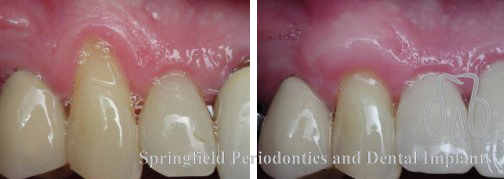Treatment
Periodontal Treatments
These are treatments to treat the infection that destroys the bone support of your teeth. Every treatment plan is customized for you based on your goals, the extent of the disease, and the findings at your examination appointment. We are always happy to discuss treatment options with you along with the advantages and disadvantages of each approach.
Scaling and Root Planing (Deep Cleaning)
This is a non-surgical approach to treat periodontal disease and often the place where we begin treatment. With the gums numb the deposits of plaque and calculus in the pockets are removed with ultrasonic and hand instruments. By thoroughly cleaning the roots the gums have the opportunity to reattach, sealing up the pockets where the bacteria can accumulate. Six to Eight weeks after the deep cleaning we re-evaluate your periodontal status to determine your response to treatment. After scaling and root planing many patients do not require any further periodontal treatment. If there are areas that do not adequately respond to non-surgical therapy, those sites can be treated surgically.
Flap or Osseous Surgery
This often called “Gum Surgery”. The gum is gently lifted away from the tooth to gain access to the infection on the root of the tooth and in the bone. This is necessary in the more advanced stages of the disease or when an area does not respond to non-surgical treatment. While the gum is separated from the tooth it is often possible to rebuild the lost bone with a bone graft. Guided tissue regeneration can be done to improve the healing of a bone graft. This uses a dissolvable membrane that is placed over the bone graft to allow the bone to heal independently of the gum above it. This is often referred to as periodontal regeneration.
Gingival (Gum) Grafting

Soft tissue grafting is utilized to rebuild the gum tissue when it has been lost due to trauma, disease or in some cases, did not properly form as the teeth erupted into the mouth resulting in recession or root exposure. It is a miniature skin graft performed in the mouth. Tissue can be taken form the roof of the mouth and transplanted into another site in the mouth where additional tissue is needed. If there is adequate bone support it is often possible to cover some or all of the exposed root.
In this case, heavy deposits of tarter were removed from the teeth to treat the periodontal disease and healthy fibrous tissue was borrowed from the roof of the mouth and placed on the lower front teeth to rebuild tissue that was lost due to the disease process.
For more information see Soft Tissue Grafts on the American Academy of Periodontology web site.
Connective Tissue Graft

A connective tissue graft was used here to cover the exposed root on the eye tooth. By replacing the gum lost to recession, a normal appearing smile was reestablished. This eliminates the “long in the tooth” appearance, resulting in a more youthful smile. For more information, see Soft Tissue Grafts on the American Academy of Periodontology web site.
Crown Lengthening Procedures

Often when a tooth breaks (as in the photograph on the left) it will fracture at or under the gum line. When this happens, there is not enough tooth structure left for an adequate repair. An alternative to extraction is CROWN LENGTHENING. With this procedure, the gum around the tooth is repositioned, exposing adequate tooth structure for the restoration of the tooth with a crown. This tooth was later repaired with the placement of a crown (cap) by the patient’s dentist. For more information see Crown Lengthening on the American Academy of Periodontology web site.